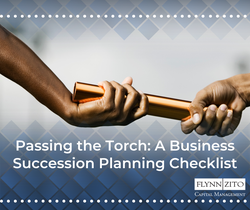
Passing the Torch: A Business Succession Planning Checklist
Business succession planning is a critical process that focuses on the smooth transition of a company's leadership and ownership from one generation to the next. This checklist serves as a valuable tool for business owners, providing guidance and outlining key steps to consider when planning for the future of their company.
1. Create manageable goals and objectives
The business leader must set goals and design objectives to help smooth the transition and integrate strategies to prepare for unexpected issues. Not having these in place could impact the business owner's decisions, creating hesitation to retire, unnecessary stress, and tension within the company.
2. Filling critical roles and identifying your successors
Now that you are stepping down, have you selected trusted individuals with positions of authority to make critical decisions for the company? This could be especially crucial if you still have significant wealth tied up in the business.
3. Design a training and development plan
It might be helpful to create a training program for management and staff to match the company’s needs with the successors’ talents and interests in the business.
4. Risk mitigation
A few suggestions for steps to take to help mitigate risk during business succession include:
· Create a manageable plan.
· Choose qualified people for the necessary positions.
· Provide training and have an understanding of the blueprint for succession.
· Follow the steps you and your financial professional have created that align with your strategy and adhere to a risk management model.
· Be open and transparent with those involved in the business succession.
5. Valuation of the business
A business valuation gives an accurate picture of what a company is worth. Conducting a business valuation is critical for tax planning and estate planning, allowing for a fair distribution of the assets to business successors and family members. Generally, there are three methods for determining the value of the business:
· Income Approach – This method examines the level of risk and expected economic benefit related to the investment.
· Asset Approach – This method determines the value of the company’s assets less liabilities, tangible and intangible.
· Market Approach – This method compares your company and similar businesses recently sold.
6. Determine your exit strategy
Do you want to retain any control of the business after you pass it off or would you rather make a clean break? Have everything in order before you go and commit to your plan.
7. Consult your financial professional
Planning for business succession is a big life step and a complex process. Make the transition for yourself and your business as painless as possible by scheduling a meeting with your financial professional.
Important Disclosures:
The opinions voiced in this material are for general information only and are not intended to provide specific advice or recommendations for any individual.
This information is not intended to be a substitute for specific individualized tax or legal advice. We suggest that you discuss your specific situation with a qualified tax or legal advisor.
All information is believed to be from reliable sources; however, LPL Financial makes no representation as to its completeness or accuracy.
This article was prepared by LPL Marketing Solutions.
LPL Tracking #509419
Sources: setting-goals-and-objectives-for-an-effective-family-business-succession-plan-1.pdf (kpmg.com) Understanding the Role of Business Valuation in Succession Planning (linkedin.com) How to Create an Employee Training Plan in 10 Steps (sandiego.edu) Business Exit Strategy: Definition, Examples, Best Types (investopedia.com)
